North High School
Friday, September 26th, 2008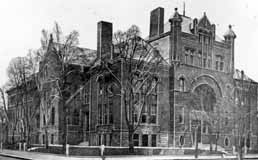 The original North High School, located at 100 West 4th Street at the corner of 4th Avenue and Dennison Avenue, had opened its doors on February 3, 1893 with eight teachers and 300 students. The student body quickly outgrew the building and an annex was constructed in 1902. That, too, became overcrowded.
The original North High School, located at 100 West 4th Street at the corner of 4th Avenue and Dennison Avenue, had opened its doors on February 3, 1893 with eight teachers and 300 students. The student body quickly outgrew the building and an annex was constructed in 1902. That, too, became overcrowded.
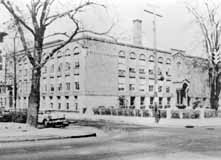 After a new high school was completed, the old building became Everett Junior High School, named after the first North High School principal C. D. Everett. This first building—designed by Frank Packard and built at a cost of $14,000—is still in use. As shown in the lower photograph, the turrets and other elaborate structures have since been removed from the school. (Photo courtesy of Columbus Metropolitan Libraries)
After a new high school was completed, the old building became Everett Junior High School, named after the first North High School principal C. D. Everett. This first building—designed by Frank Packard and built at a cost of $14,000—is still in use. As shown in the lower photograph, the turrets and other elaborate structures have since been removed from the school. (Photo courtesy of Columbus Metropolitan Libraries)

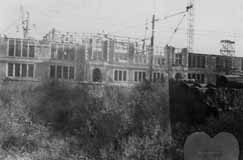
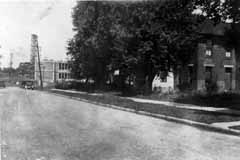 In 1921, the Columbus Board of Education purchased 13.15 acres for $35,000 to build a new high school. The property had been owned by the American Vitrified Products Company. The land bordered on a deep ravine; the ravine was considered to be an asset for science classes, as was the proximity of the property to the streetcar tracks. Many other sites had been considered, including somewhere on the campus of Ohio State University. Discarded bricks and baked clay shards had to be removed from the old brick yard before construction of the school could begin. The new building was designed by architect Frank Packard and cost $1,000,000. Construction began in 1923 and the building opened on September 2, 1924. It graduated its first class in January of 1925. For a brief time, the new high school was named Edward Orton High School. It served as an anchor for the community; often three generations of Clintonville families attended the school. It was one of the city’s top college-preparation schools; between 90 and 95 percent of the students went on to higher education. North High School was closed in 1979 as part of the city’s desegregation plan and subsequently became an adult education center and has also served as temporary quarters for schools undergoing renovations. (Photos courtesy of Leeann Faust)
In 1921, the Columbus Board of Education purchased 13.15 acres for $35,000 to build a new high school. The property had been owned by the American Vitrified Products Company. The land bordered on a deep ravine; the ravine was considered to be an asset for science classes, as was the proximity of the property to the streetcar tracks. Many other sites had been considered, including somewhere on the campus of Ohio State University. Discarded bricks and baked clay shards had to be removed from the old brick yard before construction of the school could begin. The new building was designed by architect Frank Packard and cost $1,000,000. Construction began in 1923 and the building opened on September 2, 1924. It graduated its first class in January of 1925. For a brief time, the new high school was named Edward Orton High School. It served as an anchor for the community; often three generations of Clintonville families attended the school. It was one of the city’s top college-preparation schools; between 90 and 95 percent of the students went on to higher education. North High School was closed in 1979 as part of the city’s desegregation plan and subsequently became an adult education center and has also served as temporary quarters for schools undergoing renovations. (Photos courtesy of Leeann Faust)
 This diminutive Pure Oil gas station was located at the corner of Hudson and Indianola. It had an outdoor lift instead of service bays. The pump globes say Purol and Detonox, indicating the photograph is from the 1920s. Service bays were added to the station later in the decade. Union 76 purchased Pure Oil in 1965, and completely refashioned the station.
This diminutive Pure Oil gas station was located at the corner of Hudson and Indianola. It had an outdoor lift instead of service bays. The pump globes say Purol and Detonox, indicating the photograph is from the 1920s. Service bays were added to the station later in the decade. Union 76 purchased Pure Oil in 1965, and completely refashioned the station. 
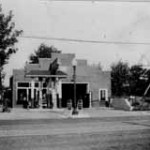
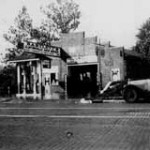
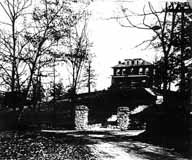
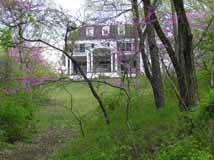
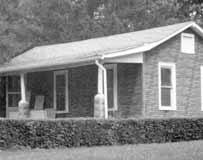 This house at 200 Glenmont is now gone, but it originally belonged to Sarah Breunig and her husband. Sarah moved to Clintonville as a young wife, before Glenmont was paved and before indoor plumbing. Sarah became one of the original community leaders of the Overbrook area. Sarah was a founding and active member in the Maple Grove Methodist Church, the Glenmont Community Club, Navy Mothers, and the Clintonville Women’s Club. She became the first female president of the Glenmont Community Club in 1968. (Photo courtesy of the Kerchner family)
This house at 200 Glenmont is now gone, but it originally belonged to Sarah Breunig and her husband. Sarah moved to Clintonville as a young wife, before Glenmont was paved and before indoor plumbing. Sarah became one of the original community leaders of the Overbrook area. Sarah was a founding and active member in the Maple Grove Methodist Church, the Glenmont Community Club, Navy Mothers, and the Clintonville Women’s Club. She became the first female president of the Glenmont Community Club in 1968. (Photo courtesy of the Kerchner family)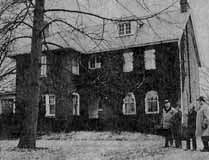 The Glenmont Community Club first met on March 2, 1921 at 45 Glenmont to “discuss improvements pertinent to the community.” It met at the Stella Wilson home; Stella was head of the science department of the old High School of Commerce (later known as Central High School) and had purchased the house in 1920 at the age of 58. Miss Wilson served as secretary and remained a primary force in the Glenmont Community Club until her death. Stella’s sister Ida was a physician; Ida acquired the house in the 1930s after Stella died. (Photo courtesy of the Kerchner family)
The Glenmont Community Club first met on March 2, 1921 at 45 Glenmont to “discuss improvements pertinent to the community.” It met at the Stella Wilson home; Stella was head of the science department of the old High School of Commerce (later known as Central High School) and had purchased the house in 1920 at the age of 58. Miss Wilson served as secretary and remained a primary force in the Glenmont Community Club until her death. Stella’s sister Ida was a physician; Ida acquired the house in the 1930s after Stella died. (Photo courtesy of the Kerchner family)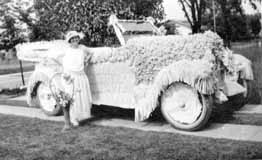 During Clintonville’s early years, it had many parades and this is one of the floats. The back of the photograph is labeled the “Lehman Machine” (machine was another name for automobile). According to the 1923 city directory, there was a David and Hattie Lehman living at 47 West Brighton Road. David was a sales manager for the Iron Clay Brick Company, and Hattie was a hemstitcher. (Photo courtesy of Amy Westervelt)
During Clintonville’s early years, it had many parades and this is one of the floats. The back of the photograph is labeled the “Lehman Machine” (machine was another name for automobile). According to the 1923 city directory, there was a David and Hattie Lehman living at 47 West Brighton Road. David was a sales manager for the Iron Clay Brick Company, and Hattie was a hemstitcher. (Photo courtesy of Amy Westervelt)